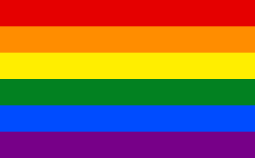 The most popular version of the flag, with six stripes, first introduced in 1979 | |
| LGBTQ Pride flag | |
| Use | Association with the LGBTQ community |
|---|---|
| Adopted | 1978 |
| Design | Striped flag, typically six colors (from top to bottom): red, orange, yellow, green, blue, and violet. |
| Designed by | Gilbert Baker |
| Part of the LGBTQ series |
| LGBTQ symbols |
|---|
| Symbols |
| Pride flags |
The rainbow flag or pride flag (formerly gay pride flag) is a symbol of LGBTQ pride and LGBTQ social movements. The colors reflect the diversity of the LGBTQ community and the spectrum of human sexuality and gender. Using a rainbow flag as a symbol of LGBTQ pride began in San Francisco, California, but eventually became common at LGBTQ rights events worldwide.

Originally devised by the artists Gilbert Baker, Lynn Segerblom, James McNamara and other activists,[1][2][3][4] the design underwent several revisions after its debut in 1978, and continues to inspire variations. Although Baker's original rainbow flag had eight colors,[5][6] from 1979 to the present day the most common variant consists of six stripes: red, orange, yellow, green, blue, and violet. The flag is typically displayed horizontally, with the red stripe on top, as it would be in a natural rainbow.
LGBTQ people and allies currently use rainbow flags and many rainbow-themed items and color schemes as an outward symbol of their identity or support. There are derivations of the rainbow flag that are used to focus attention on specific causes or groups within the community (e.g. transgender people, fighting the AIDS epidemic, inclusion of LGBTQ people of color). In addition to the rainbow, many other flags and symbols are used to communicate specific identities within the LGBTQ community.
- ^ "Long-Lost Fragment of First Rainbow Pride Flag Resurfaces After Four Decades".
- ^ "The Rainbow Flag: Lynn Segerblom & Lee Mentley". October 2, 2023.
- ^ "The woman behind the Rainbow Flag". March 3, 2018.
- ^ "HERSTORY – Meet Lynn Segerblom, One of the Creators of the Original 1978 Rainbow Flag - WeHo Times West Hollywood Daily News, Nightlife and Events". July 18, 2018.
- ^ "The Rainbow Flag". Retrieved May 29, 2021.
- ^ Gilbert Baker (October 18, 2007). "Pride-Flyin' Flag: Rainbow-flag founder marks 30-years anniversary". Metro Weekly. Retrieved March 13, 2008.